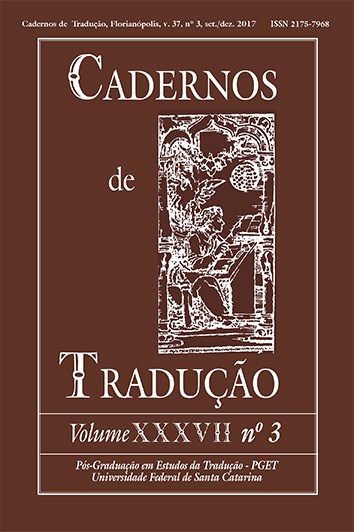Flynn, Peter, et al. Interconnecting Translation Studies and Imagology. Amsterdam: John Benjamins Publishing Company, 2016, 340 p
DOI :
https://doi.org/10.5007/2175-7968.2017v37n3p306Résumé
Contrary to the idea of following a precise conceptual plan in what concerns translation choices and beliefs, and to the detriment of traditional more prescriptive views on translation techniques, the possibility of intuition and creativity surface from contemporary critiques upon the matter. Such shift has not only bestowed translations with a deserved arena for them to perform their task, but has actually provided them with important tools for one to position him/herself socially and politically in what regards an issue that have always been social and political: the text. When I kidnap meaning from the original and suggest it actually belongs to every instance that happens to touch it, the autonomy inevitably directed by this process towards translator and reader ultimately grants both an opportunity to inflict a material and consistent influence on such meaning. That is, when I pose that meanings do not belong to the original, such meanings end up losing their status of “possessions” – and eventually one learns they do not belong to anyone at all. The question one might be asking is: why would this autonomy to transform necessarily change anything for those involved in the enterprise of translation? Well, it does change many things; not to say everything. As translators acknowledge the active role they play for the maintenance or alteration of certain narratives, their task is no longer taken as a simple – uncontrollable – code transferring; i.e., translators are turned from rewriters into writers, from carriers of old meanings into inventers of new ones. In the book Interconnecting Translation Studies and Imagology (2015) – edited by Peter Flynn, Luc van Doorslaer, and Joep Leerssen – the authors and compiled articles address the fact that it is only through a more autonomous notion of translation that questionable cultural aspects, as well as prejudiced images of this or that tradition, might be finally overcome.Téléchargements
Publiée
2017-09-05
Comment citer
Gonçalves, D. S. (2017). Flynn, Peter, et al. Interconnecting Translation Studies and Imagology. Amsterdam: John Benjamins Publishing Company, 2016, 340 p. Cadernos De Tradução, 37(3), 306–316. https://doi.org/10.5007/2175-7968.2017v37n3p306
Numéro
Rubrique
Resenhas
Licence
Autores mantêm os direitos autorais e concedem à revista o direito de primeira publicação, com o trabalho simultaneamente licenciado sob a Licença Creative Commons Atribuição 4.0 Internacional (CC BY) que permite o compartilhamento do trabalho com reconhecimento da autoria e publicação inicial nesta revista.
Autores têm autorização para assumir contratos adicionais separadamente, para distribuição não exclusiva da versão do trabalho publicada nesta revista (ex.: publicar em repositório institucional ou como capítulo de livro, com reconhecimento de autoria e publicação inicial nesta revista).





















































